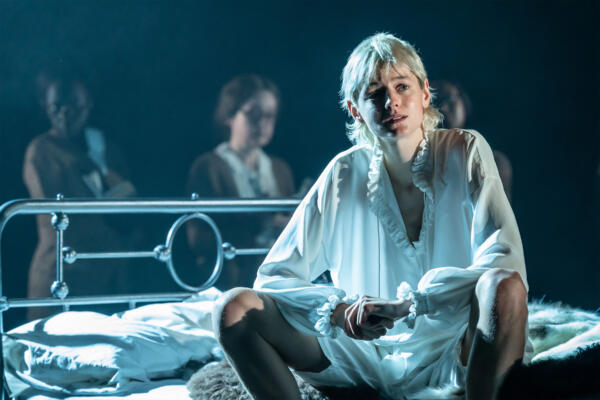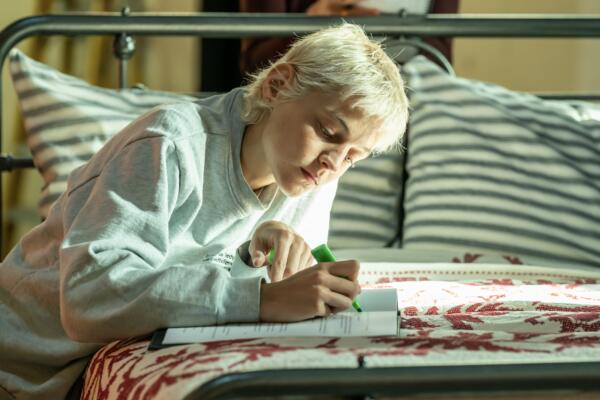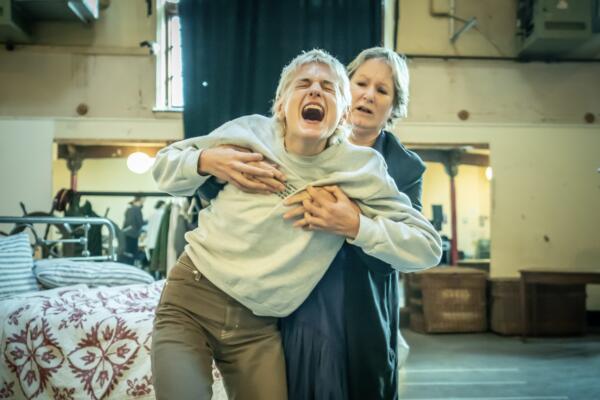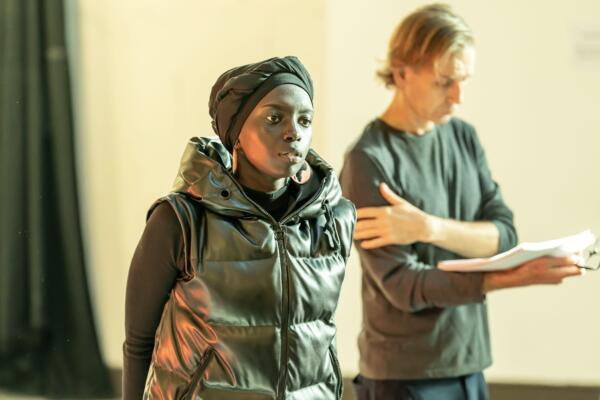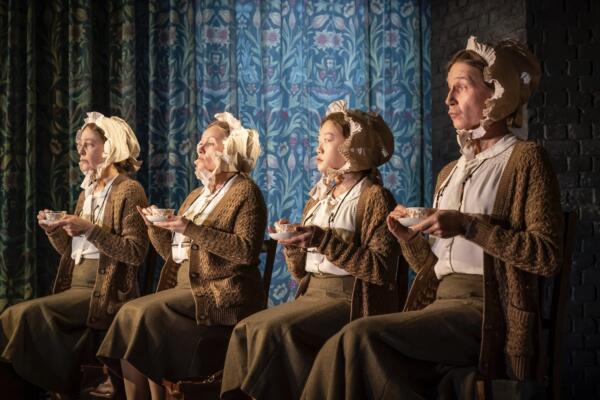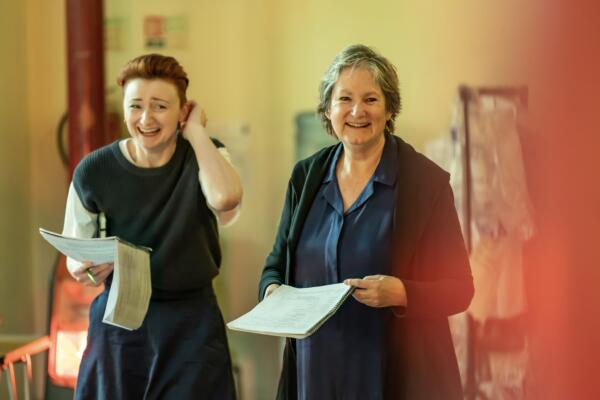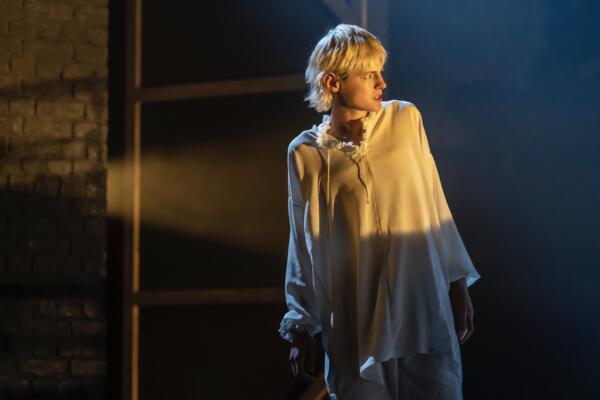Hughie | Rehearsal Diary
Hughie– Week Two
After a much-deserved day off, we resume our work in the rehearsal room – deepening our exploration and refining the narrative. Before the session even begins, Michael is checking-in with Forest: What feels good? What are you worried about? What’s unclear from week one? Forest replies that he’s feeling good about the stories and dialogue with Frank’s character, in isolation, but stringing them together – the transitions between them – still feels strange and undiscovered.
Michael refers to these moments of transition as ‘corners’. He takes this term from music, when a passage or phrase of music turns and becomes another phrase. It’s not a full-stop between scenes or stories, but rather an active moment of transition that strings a whole play together. Michael finds them to be some of the most exciting moments in a play and I have to agree. It’s a thrill to cull them out in rehearsals and watch them energise the piece.
Michael structures the first day of week two around the corners. We start at the top of the play and anytime we encounter a corner we stop. First we identify it collectively, making sure we’re all on the same page and agree that is, in fact, a corner. Next, we ensure it’s being energised for its maximum potential – that the momentum of the play continues, and possibly even builds, through the transition and that we launch into the next beat or story retaining the audience’s interest. Finally, we go back a few lines or pages and run the corner again. And then again if needs be. It’s a start-and-stop process, but as we continually remind ourselves – it’s only an hour-long play.
Michael’s focus on the exploration of corners is total. It’s a terrific lesson in committing to a director’s objective for rehearsals. He’s a great example of never letting his confidence get in the way of exploration. Even when we pass a corner that plays beautifully and clearly, Michael will stop the process and check-in with the actors, asking: ‘Was that clear? It was clear to me, but let’s make sure it’s clear to all of us and we all know what we did.’
This work continues throughout the second week as we deepen our exploration and refine the narrative. Michael maintains his restraint in never letting us have a full run through. He’s always one to caution about getting too fast too early. The length of this play is, again, our great advantage.
Erie is a depressive character: down on his luck, fighting off delirium tremens, mourning the loss of his friend. But theatre is active – acting is active. We therefore spend a portion of week two examining an important question: How do you keep depression energised? Forest finds some of the energy in his and Erie’s generally upbeat nature. Erie, and certainly Forest’s Erie, has a cheery attitude of, ‘Something always works out in the end’. This optimism becomes an active force in fighting off the depressive energy that can cause problems theatrically. The brightness fights to shine through the dark.
Several key pieces of blocking we discovered in the first week involve Erie sitting down on the steps or a chair, which show both his exhaustion and familiarity with the hotel lobby. In our quest for an active drama, Michael makes an excellent adjustment. He coaches Forest to make the sitting down an ‘active depression’ – that Erie is sitting down with the urgent purpose of working something out, and in doing so discovers something new on his journey.
Michael likes to incorporate as many elements of production into the rehearsal room as he can, so that when we move to the theatre the actors are adjusting to as little as possible. This week we begin to incorporate Adam Cork’s music and soundscape, plus Christopher Oram’s costume pieces. (If Michael could incorporate Neil Austin’s lights, I think he would, but this show and rehearsal room don’t allow it.)
Adam attended rehearsals throughout the first week. Laptop in front of him and massive headphones over his ears, he watched and listened to the play, noting places where there might be passing footfalls or the sound of an elevated train. He also spent time measuring the number of seconds Forest was taking for certain beats and planned moments of reflection on stage where original music may be used. This week we’ve now started to play those sound cues in rehearsal.
Introducing sound and music into a play is always a specific process for Michael. First he listens to it over headphones, giving Adam any necessary adjustments. Next, we listen to it through speakers with the actors in isolation from ‘acting’ the scene. Finally, we play the scene fully, completely integrating the sound. All the while, Michael stresses that the sound or music – or any production element for that matter – should come entirely from the actor and out of their choices, not the other way round. A sound cue should never feel like something layered on by the director or design team. It should be a natural and organic expression coming from the characters’ action. We work each sound and piece of music into the play slowly. By the time we’ve finished we’re naturally running longer sections, gearing up towards the inevitable and much-anticipated run through.
On Friday morning, our tenth day of work, we put it all together. Forest is wearing Erie’s suit and hat and Adam’s music is playing along, bringing us into the world of 1928. While the whole process is certainly drawn out and bumpy in parts, we run through the play from start to finish. Once we sit down for notes, Michael states: ‘Well, that’s a very big boil lanced!’ Indeed it is.
In the afternoon we work through several sections that needed work from the morning session. After that the clock reads 4.30pm. We have about an hour left of the day and Michael leaves the decision about what to do with it to Forest. He views rehearsals as the time for Forest to get what he needs, as much as for the production to get what it requires. Forest thinks for a moment before saying, ‘Let’s go again’. So we use the last part of the day to work through the play once more. So much of a good rehearsal process is repetition.
The following day, our final in the rehearsal room, we follow much the same pattern. We start the day with a run through, this time with a small invited audience of our designers and a few producers. It goes quite well. We learn there are laughs at moments we didn’t expect, and we find that certain moments are lost on the audience and will need further work before we open to a paying audience in a week’s time. ‘We know what we’ve got to do and we’ve got plenty of time to do it,’ says Michael.
After a very positive and reassuring notes session, we break for the day and say goodbye to the rehearsal room. Next week will begin with continued acting work in the Booth Theatre for the first two days, followed by technical rehearsals and our first dress rehearsal and preview.
